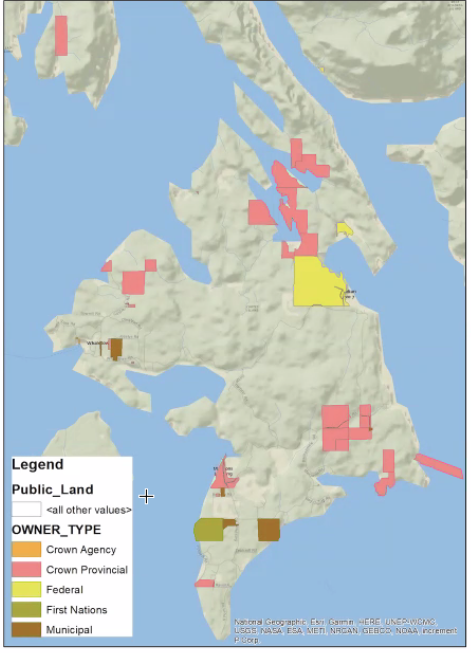UBC has developed a new Housing Assessment Resource Tool (HART) to identify sites that can be used to bridge the gap between housing needs and potential building sites in specific communities.
According to data from the 2016 census, the UBC research estimates that 1.7 million Canadian households need core housing.

The Housing Research Collaborative's first glimpse of Cortes Island: properties that might be of interest but further research is needed. Image courtesy of Housing Research Collaborative.
The vast majority are low and very low-income households that cannot pay more than $375-$750 a month for rent.
Dr. Penny Gurstein, director of UBC’s Housing Research Collaborative, identified 157/520 households paying more for accommodation than they could comfortably afford (based on the 2016 data).
She also identified parcels of federal, provincial and municipal properties on Cortes Island that might be available as housing sites.
“We did this in two minutes,” she explained. “We’re using GIS mapping to actually find out what land is available.”
The housing collaborative published a more detailed study on Kelowna last month. They identified 230 well-located government or non-profit land parcels that could be used for up to 34,620 affordable housing units.
This was just the first stage of the program’s development. During the next phase, Gurstein hopes to develop a land acquisition strategy.
“In a place like Cortes, I suspect this would be very useful,” she said.
The Housing Research Collaborative also plans to develop a training program for communities and individuals that want to use HART.
“We are hoping that this will be a way for policy makers and councils and others to start making more effective and efficient decisions.”
Gurstein said governments used to think of the housing crisis in terms of large cities, now it is everywhere.
“I think there are going to have to be some real community efforts around housing because you are going to lose your younger population, which is what you desperately need to keep communities alive,” she said.



